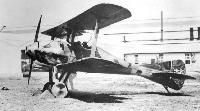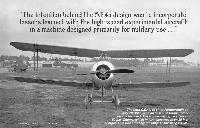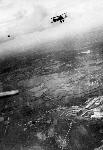Фотографии
-
Регистрационный номер: A4561 The first of a famous breed: A4561, the first prototype S.E.5, at Farnborough on November 23, 1916, in its initial form. Its first flight was made by Frank Goodden on November 22 that year.
Самолёты на фотографии: RAF S.E.5 - Великобритания - 1916
-
Регистрационный номер: 5610, 5611 [4] The second and third S.E.4as, 5610 and 5611, under construction in the F.1 Shop at Farnborough on July 15, 1915, with the forward fuselage of the fourth and final S.E.4a, 5612, in the left foreground. A couple of nacelles for F.E.2a pushers are also under construction in this fascinating photograph.
Самолёты на фотографии: RAF F.E.2 - Великобритания - 1914RAF S.E.4 - Великобритания - 1914
-
An excellent photograph of the S.E.4 in its initial form at Farnborough, with the Royal Aircraft Factory buildings as a backdrop. The single interplane I-struts were anchored to the front and rear main spars of the wings.
Самолёты на фотографии: RAF S.E.4 - Великобритания - 1914
-
Регистрационный номер: 5609 The first S.E.4a, 5609, under construction on June 8, 1915. The fins and rudder were already camouflaged, with the Union Flag painted low on the rudder, but it seems that when the rest of the aircraft’s fabric covering was completed it was clear-doped, with Service roundels atop the upper wings and on the lower-wing undersurfaces.
Самолёты на фотографии: RAF S.E.4 - Великобритания - 1914
-
Регистрационный номер: 5611 [4] The third S.E.4a, 5611, in flight. Although the S.E.4a was said to be a fine aerobatic machine, the Factory’s pilots were not enamoured of the flap gear, which did not improve performance sufficiently to warrant its general adoption.
Самолёты на фотографии: RAF S.E.4 - Великобритания - 1914
-
The same aircraft on June 25, 1915, shortly after completion, with the overwing mounting for a single machine-gun in place. This machine retained some of the streamlining refinements of the S.E.4, such as the large propeller spinner and fairing of the fuselage to circular cross-section
Самолёты на фотографии: RAF S.E.4 - Великобритания - 1914
-
Регистрационный номер: 5611 [4] Another view of the third S.E.4a, 5611, showing the rather more utilitarian slab-sided fuselage of the later examples, with semi-conical fairings to fair the circular engine cowling into the fuselage sides.
Самолёты на фотографии: RAF S.E.4 - Великобритания - 1914
-
This three-quarter-front view of the S.E.4 shortly after completion clearly portrays the original inverted pyramid of struts to which the extremely narrow-track undercarriage was attached. Also of note is the open-nosed conical propeller spinner.
The S.E.4, first powered by a 160 h.p. Gnome, was later fitted with a 100 h.p. Gnome Monosoupape.Самолёты на фотографии: RAF S.E.4 - Великобритания - 1914
-
Регистрационный номер: 628 The S.E.4’s narrow-track undercarriage was soon replaced by a more practical vee-strut and cross-axle arrangement, as seen in this study of the aircraft after it had been given a singular camouflage scheme and had the military serial number 628 applied to its rudder. The pilot lends scale to the small but very shapely airframe.
Самолёты на фотографии: RAF S.E.4 - Великобритания - 1914
-
Регистрационный номер: 5611 [4] The third S.E.4a, 5611, at Farnborough on July 29, 1915, with an 80 h.p. le Rhone rotary engine installed. The engine was replaced by an 80 h.p. Gnome, which in turn gave way to an 80 h.p. Clerget. This was probably the longest-surviving S.E.4a.
Самолёты на фотографии: RAF S.E.4 - Великобритания - 1914
-
A rare early air-to-air photograph of Frank T. Courtney flying an S.E.4a over the Royal Aircraft Factory’s distinctive buildings in August 1916, during his few months as a military test pilot at the Royal Aircraft Factory. The photograph was taken from an aircraft flown by Frank Goodden.
Самолёты на фотографии: RAF S.E.4 - Великобритания - 1914
-
A sad end for the S.E.4, now wearing wartime camouflage. Folland’s caption reads “17.6.14: S.E.4 160 Gnome. Bad landing”. Did the S.E.4 wear camouflage before the outbreak of war, or has Folland confused the date? - the RAE gives this date for a photograph of the unpainted S.E.4 with its original inverted-tripod undercarriage.
The precise cause of the S.E.4’s crash on August 12, 1914, while piloted by Norman Spratt, is not known, but a forced landing on the rough Farnborough terrain might well have caused its starboard wheel to fail with the result seen here. The aircraft was not repaired. But for this unfortunate mishap, the aircraft may have joined the RFC in the field.Самолёты на фотографии: RAF S.E.4 - Великобритания - 1914
-
ABOVE Folland's rough notebook sketch of the S.E.4 with his centre-of-gravity calculations, showing the transparent canopy intended to enclose the cockpit, which was tested on a windtunnel model but never fitted to the aircraft itself, farnborough air sciences
Самолёты на фотографии: RAF S.E.4 - Великобритания - 1914
-
Another of Folland’s sketches, this one for an armoured “Proposed Scout”, dated December 28, 1914, displays distinct S.E.4 derivation, but the I-struts have been abandoned and replaced by a more conventional interplane strut system. The proposed wing chord was 4ft 6in (1-37m) and the track for the 24in (61cm) mainwheels was to be 4ft 9in (1-45m).
Самолёты на фотографии: RAF S.E.4 - Великобритания - 1914
-
This Royal Aircraft Factory side elevation of the S.E.4a, drawing number A4501, dated September 27, 1914, shows it to be very different from the S.E.4. The somewhat oversized head fairing on the fuselage top-decking immediately behind the cockpit is conspicuous. The machine looks far more like a fighter than the unarmed high-speed scout that formed the basis of the original concept.
Самолёты на фотографии: RAF S.E.4 - Великобритания - 1914
Статьи
- -
- ??? - Gone Fishin'!
- A.Tincopa - Wings over Peru
- B.Dunnell - Falklands confidential
- D.Gordon, I.Bott - Days of Thunder
- E.Wild - West Africa Wins Again ... or pigs can fly
- G.Alegi - ... a 350 lb Mystery
- J.Picarella, C.Koberg - Sunken treasure?
- J.Pote - A Close Shave at Wellington
- M.Garden - Oscar Garden the Sundowner of the Skies
- N.Stroud - The Last of the Many
- P.Davidson - Off the Beaten Track...
- P.Jarrett - Pioneering the Fighter (2)
- P.Vabre - Any port in a storm ... From Qantas Empire Airways
- R.Tisdale, A.Vercamer - Before & After














